Archive for October, 2016
October 29th, 2016 by dave dorsey
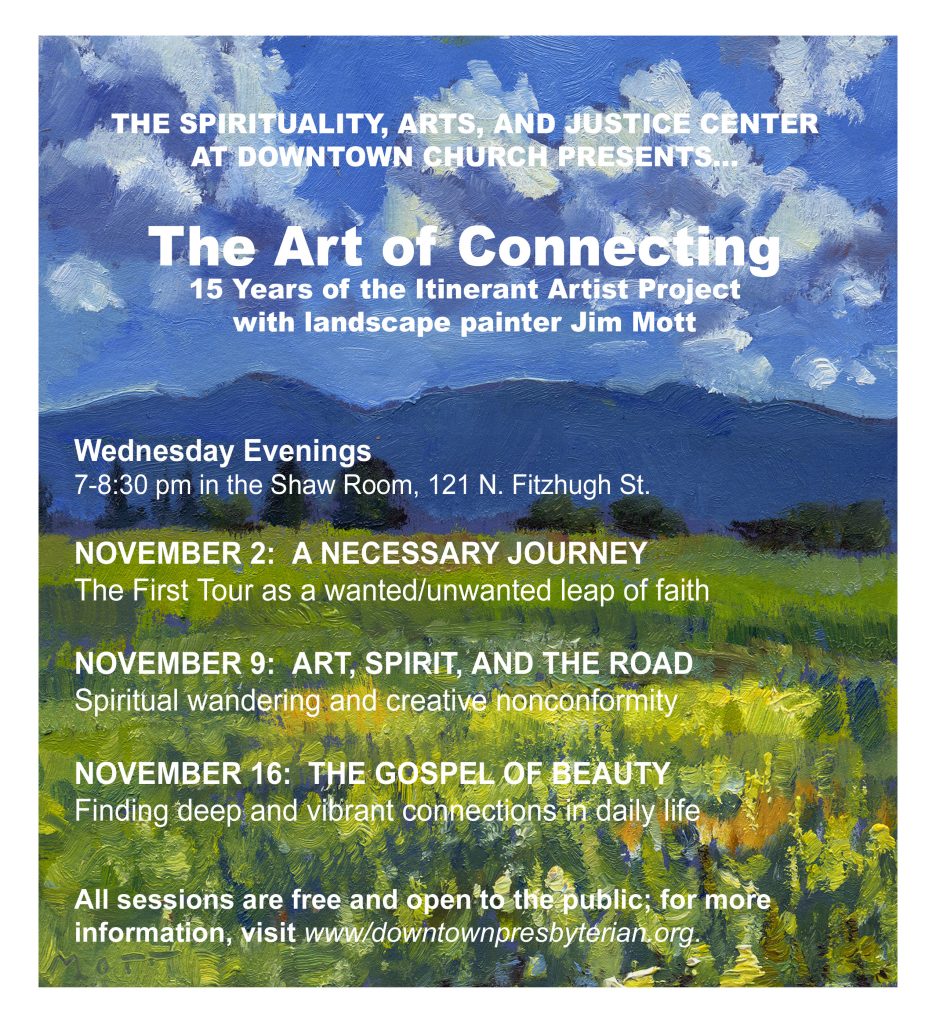
Jim Mott’s lecture series
When: November 2nd, 9th, 16th at 7:00 p.m.
Location: Center for Creativity, Spirituality and Justice, Downtown United Presbyterian Church, Shaw Room (2nd floor), 121 N. Fitzhugh St.
NOV. 2: A NECESSARY JOURNEY
The First Tour: cross-country creative odyssey.
NOV. 9: ART, SPIRIT, AND THE ROAD
Spiritual wandering and creative nonconformity.
NOV. 16: THE GOSPEL OF BEAUTY
Finding deep connections in everyday life.
October 28th, 2016 by dave dorsey
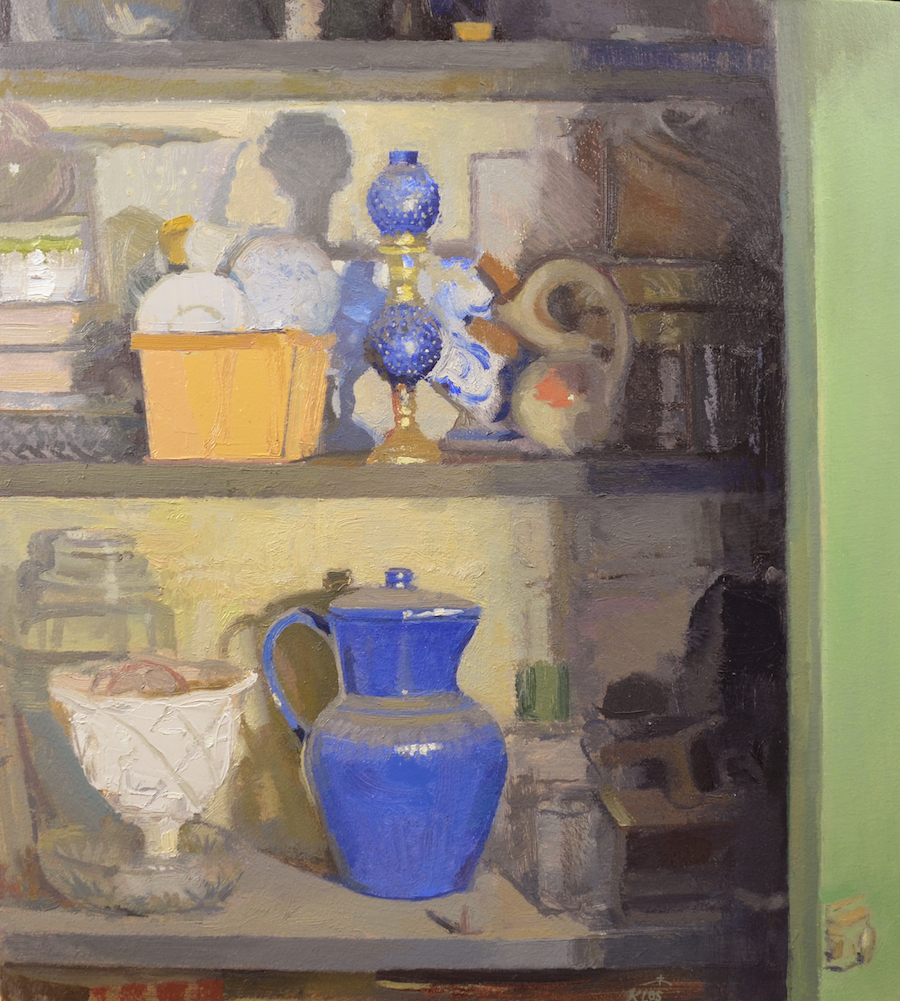
Sediment, Blue Pitcher, Matt Klos
I got a notice from Matt Klos, a fellow Oxford Gallery artist, that his work will appear in three fine exhibitions this fall. I wish I could see another two-artist or solo show of his work here again at Oxford. Kudos to Klos:
Carspecken Scott Gallery
French & Italian Landscapes by Matt Klos
& Italian Drawings by Cleveland Morris
Please join me for an exhibition of paintings I created on Mount Acuto while staying at the Barnes Artist Residency (2014) and while an artist in residence at the Alfred & Trafford Klots International Program for Artists (2010). The ever talented Cleveland Morris will be showing new Italian Drawings as well.
Opening Reception: Thursday, October 27, 2016
Carspecken Scott Gallery
1707 North Lincoln Street
Wilmington, Delaware 19806
___________________
Annapolis City Hall
Hypnagogia
Klos continues to work with interior themes and in a new series, Hypnagogia, he brings the outside in. His 2013 series of 35 plein air paintings portraying the houses of Fort Howard appear in the new interior works. The “house portraits” now fragment and color the underworld interior of a basement studio. The new paintings hover between the realms of abstraction/representation, real/imagined, and direct/indirect modes of painting; they are betwixt and between, capturing the transitional state of moving into a new state of consciousness.
November 1-28th
Reception, November 14th
Annapolis City Hall
160 Duke of Gloucester St
Annapolis, Maryland 21401
___________________
Delaware College of Art and Design
Toni & Stuart B. Young Gallery
The Un-Still Life
Can a still life be a face or even a body? Can a basket of fruit suggest a hillside? Does a single stick of chalk constitute a still life? And does a still life always have to be set upon a table? “The Unstilllife” celebrates the eccentric possibilities of still life and is a collection of works by Zeuxis, an association of still life painters that has presented group shows in New York City and around the United States since 1995. Painter Trevor Winkfield, who shows at Tibor de Nagy Gallery in New York and whose highly regarded work as an art writer includes co-founding the journal The Sienese Shredder, is collaborating with Zeuxis to organize the exhibition.
November 4 – January 14th
Opening: Friday November 4th
Delaware College of Art and Design
Toni & Stuart B. Young Gallery
600 North Market Street
Wilmington, DE 19801
_____________________
Matt Klos is an Associate Professor of Visual Arts at Anne Arundel Community College, a three time winner of the Maryland State Arts Council Individual Artist Award (2016, 2012, 2008), a winner of the Bethesda Painting Awards (2007), and received an Elizabeth Greenshields Foundation Grant in 2001.
October 26th, 2016 by dave dorsey
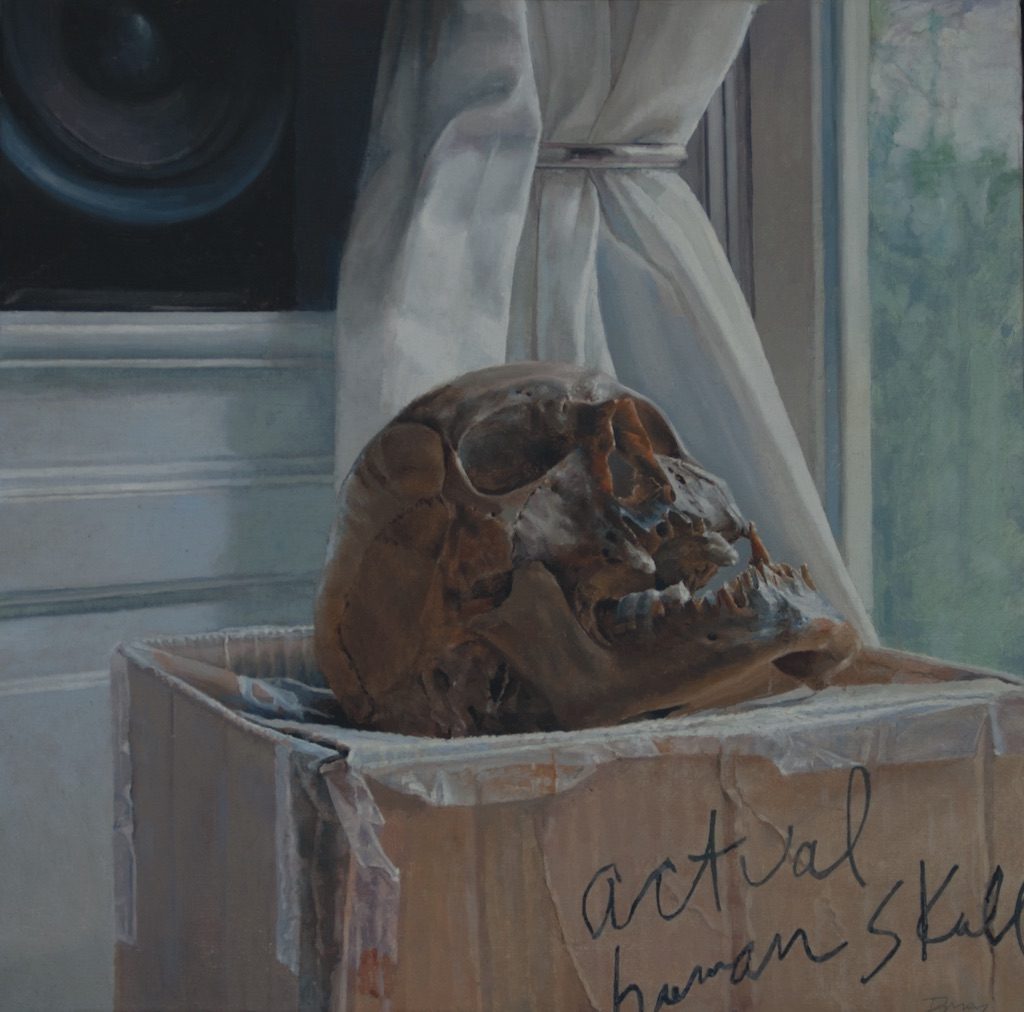
Human Skull, Unearthed circa 1930
Human Skull, Unearthed circa 1930 will be on view in “Concerning the Spiritual,” along with work from around the U.S. as well as Egypt, at the Foundry Art Centre, Satin Charles, Missouri, from Nov. 18 through Jan. 6. This painting has logged more mileage, literally, than almost anything else I’ve done. Its exhibition history is more extensive than most of my paintings, having been included in shows at Manifest, Florida State University Museum of Fine Art, Memorial Art Gallery, and Viridian Artists.
October 24th, 2016 by dave dorsey
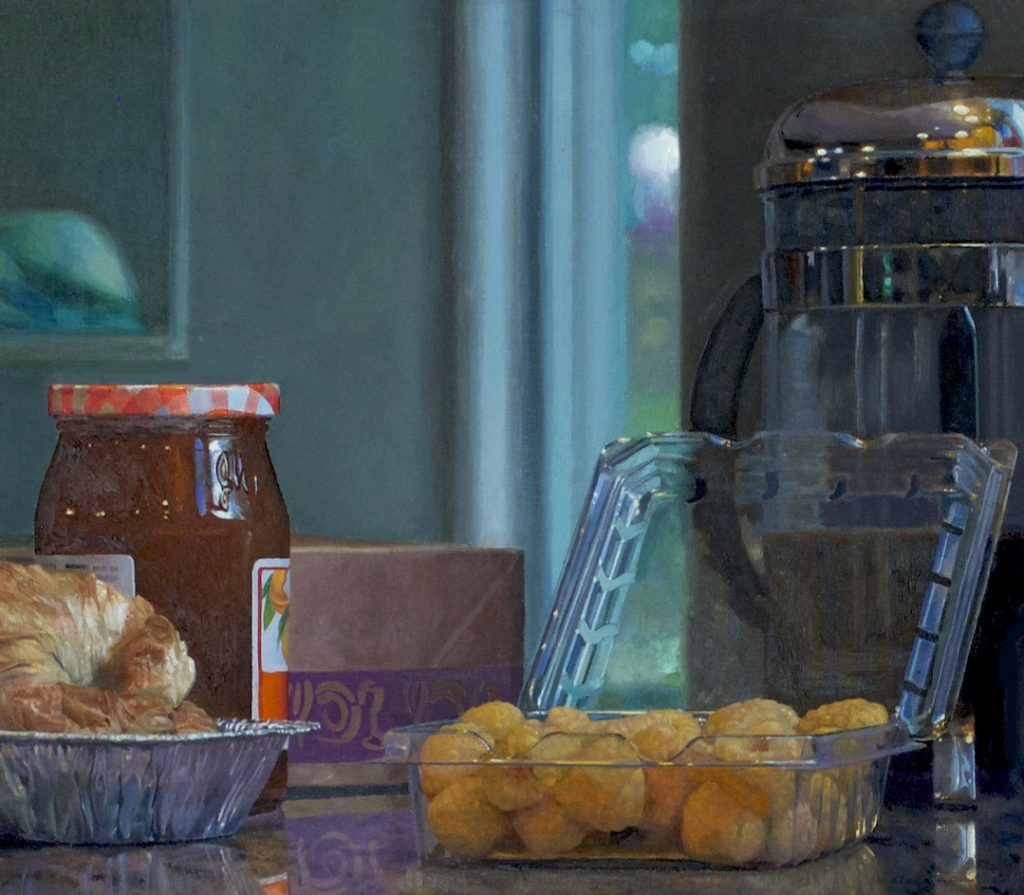
Breakfast with Golden Raspberries, detail, oil on linen, 46″ x 26″
Breakfast with Golden Raspberries will be on view at the Marin Museum of Contemporary Art, Novato, California, from Oct. 29 through Dec. 4. The exhibition was curated by Susan Snyder, co-founder of the Caldwell Snyder Gallery in San Francisco. I completed this painting over the summer, after working much longer on it than I had anticipated–but this one required all the 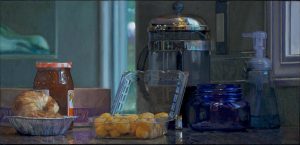 stamina and grit I applied to its execution, lingering for quite a while on the clear poly carton for the berries and the coffee maker behind it. I managed to catch some subtle effects of multiple light sources in a way that I haven’t attempted in any other painting. In reality, there were actually ten different sources of light present in this little domestic tableau: three windows and seven artificial lights situated in different places throughout the kitchen. You can see the ceiling lights reflected as little orbs in the stainless steel bands and lid of the French press. And yet with all that light, coming from nearly every direction, some areas of color nearly melt into others because they are tucked away and shielded from most of the direct light.
stamina and grit I applied to its execution, lingering for quite a while on the clear poly carton for the berries and the coffee maker behind it. I managed to catch some subtle effects of multiple light sources in a way that I haven’t attempted in any other painting. In reality, there were actually ten different sources of light present in this little domestic tableau: three windows and seven artificial lights situated in different places throughout the kitchen. You can see the ceiling lights reflected as little orbs in the stainless steel bands and lid of the French press. And yet with all that light, coming from nearly every direction, some areas of color nearly melt into others because they are tucked away and shielded from most of the direct light.
October 22nd, 2016 by dave dorsey
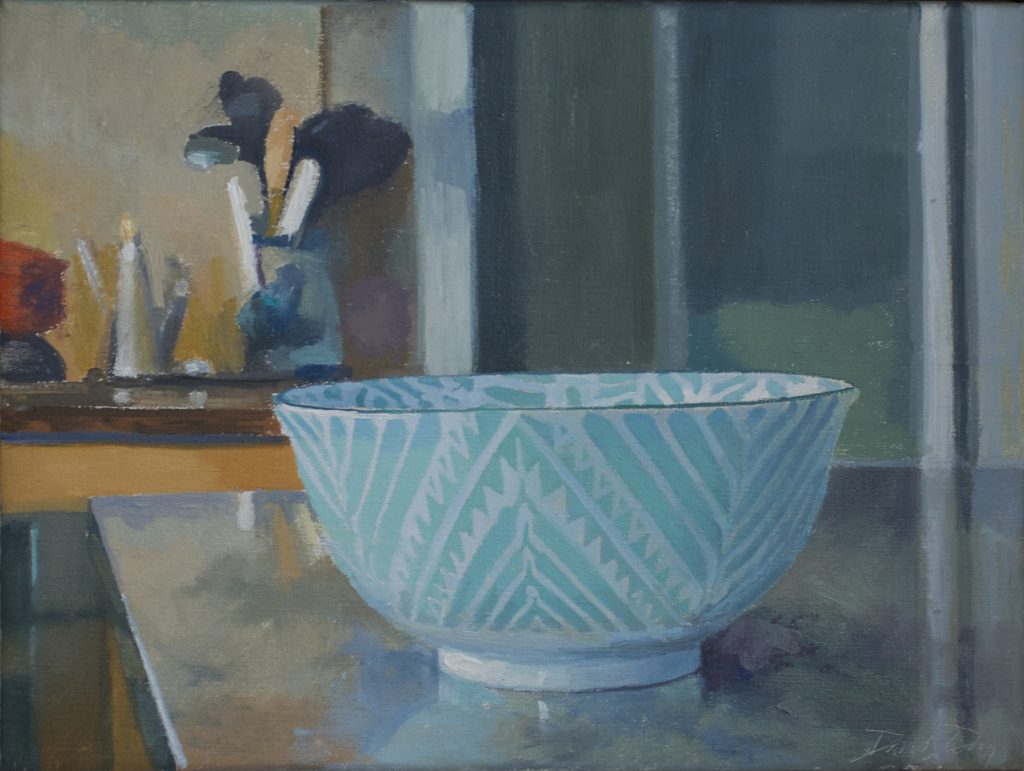
Chevron Bowl, oil on linen, 12″ x 16″
Chevron Bowl will be on view at the 2016 International Juried Exhibition at the Center for Contemporary Arts, in Bedminster, New Jersey, from Nov. 10 through Dec. 23. The exhibition was curated by Jonathan Goodman, an art writer and poet based in New York. He teaches at Pratt Institute in Brooklyn. This is one among a series of paintings of patterned bowls I’ve been working on this year with Fairfield Porter in mind. In this series, I’ve been trying to focus less on rendering the image with photographic precision, concentrating more on conveying light and color and pattern with an emphasis on more visible mark-making. I was gratified that this one made it into the show, because I was happier with the results in this painting than in nearly any other painting in the series. I’m going to keep working in this vein, following where it leads, while I also continue to do the sort of images I usually do. The line between this approach and the other is porous and a little unstable–I can start a painting thinking I’m going to be in one mode and find myself migrating into the other–but it’s a distinction that matters to me. What’s been surprising is that things I learn in one approach sometimes open up new modifications in technique in the other approach. Personal cross-pollination.
October 21st, 2016 by dave dorsey
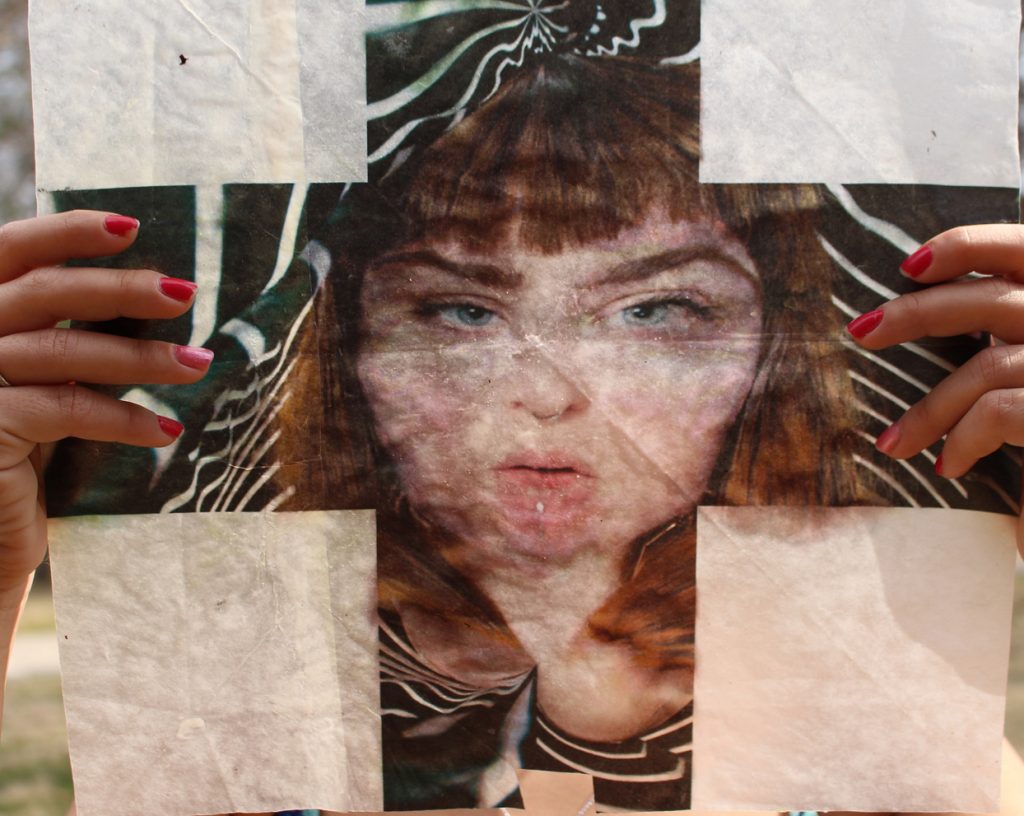
Kayleigh Harris, “Selfie”, detail. Archival pigment print within pressed wax paper.
Portraiture has become something like a new common language. With photography now a nearly daily practice for the average smartphone user, visual imagery is the favored way many people communicate who they are, what they are doing, and where they’re going. In Instagram and Snapchat’s ascendancy over Facebook, younger generations are making what they say subordinate to what they can show. The selfie has become the way people exhibit their place and role in the day-to-day world. FaceTime and Skype have turned telephone calls into face-to-face encounters: a sort of living portraiture. Even when you tap into Uber, up pops the face of the driver who is already on the way.
This is a radical shift in the role of the portrait–a shift that began with popular photography itself, history’s big Kodak moment, when George Eastman put photography within reach of the middle class. Now nearly anyone with a modest income considers it a requirement to have a phone that also doubles as a camera. As a result, many people post a continuous stream of self-portraits on the Internet. What was once a privilege for only the rich and powerful is seen now as almost a mundane obligation of contemporary life. A portrait was once something rare, costly, elegant, and almost magical. Now, MORE
October 20th, 2016 by dave dorsey
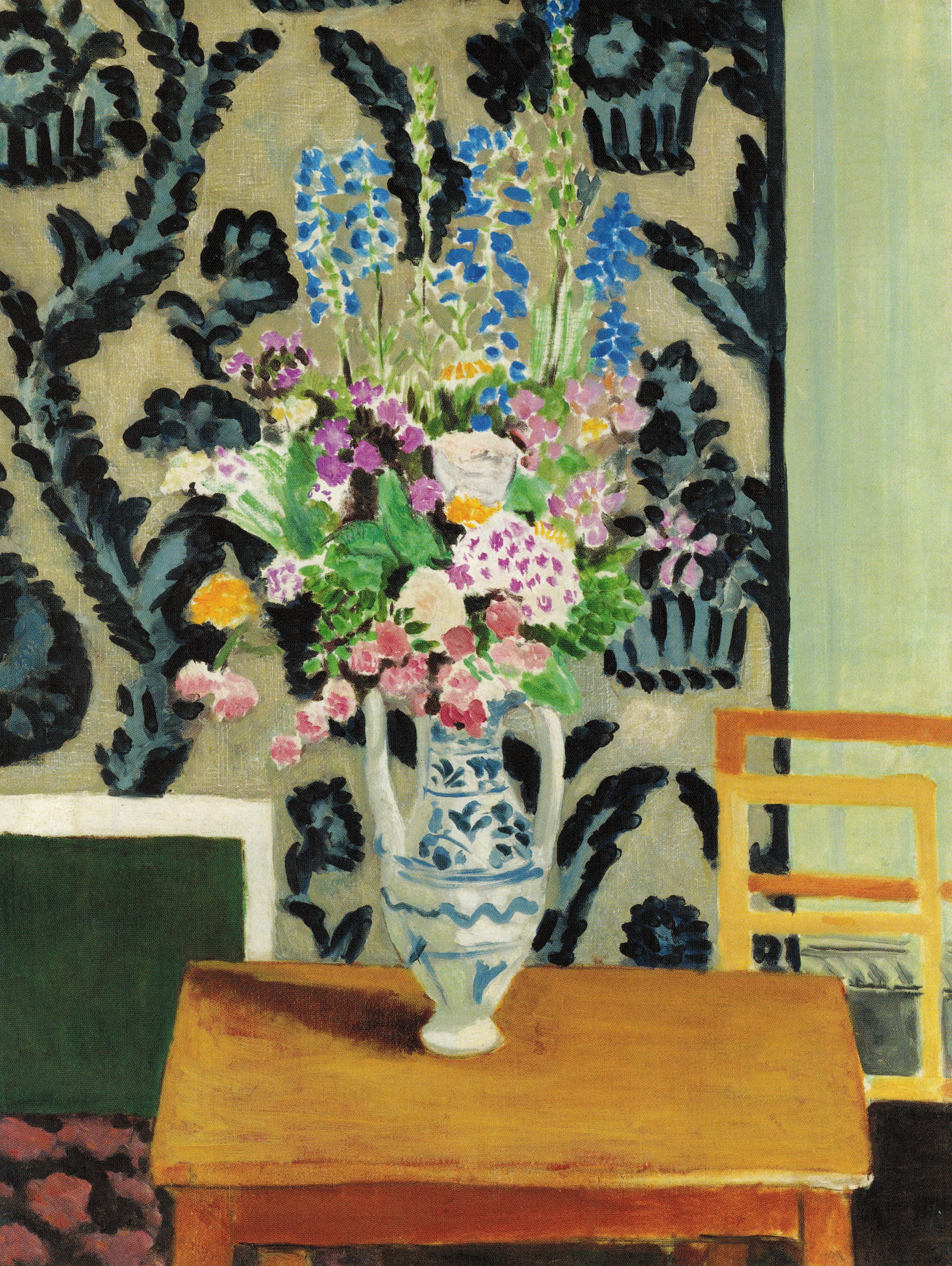
Matisse, Bouquet de fleurs pour le Quatorze Juillet, 1919
I’ve been having a conversation with Jennifer Wenker, the director of the Herndon Gallery at Antioch College, in which we have been touching on the role of art in human life. She has a show up now, Image: The Public Face, that relates to her deep interest in how art can promote social justice. It’s part of the FotoFocus Biennial in Cincinnati, an area-wide exploration with dozens of institutional participants that examines how photography does and doesn’t document reality and truth, and it has a postmodern twist of calling into question even the basic notions of reality and truth themselves. A central theme of the show is how photography has given power and a voice to people who otherwise wouldn’t have much of either–flattening the hierarchy that once put the painter in control of another person’s self-image and gave the privilege of a portrait to only the rich, powerful, and privileged. The spread of photography first through the invention of the Kodak camera and now through the popularity of the smart phone has thus become a force for social justice.
I’ve known and respected Jennifer for many years now. I participated in one of her art projects by tossing seeds into the wind down in the Finger Lakes, a memorable moment for me. (I like describing it that way because it sounds like a randomly MORE
October 18th, 2016 by dave dorsey
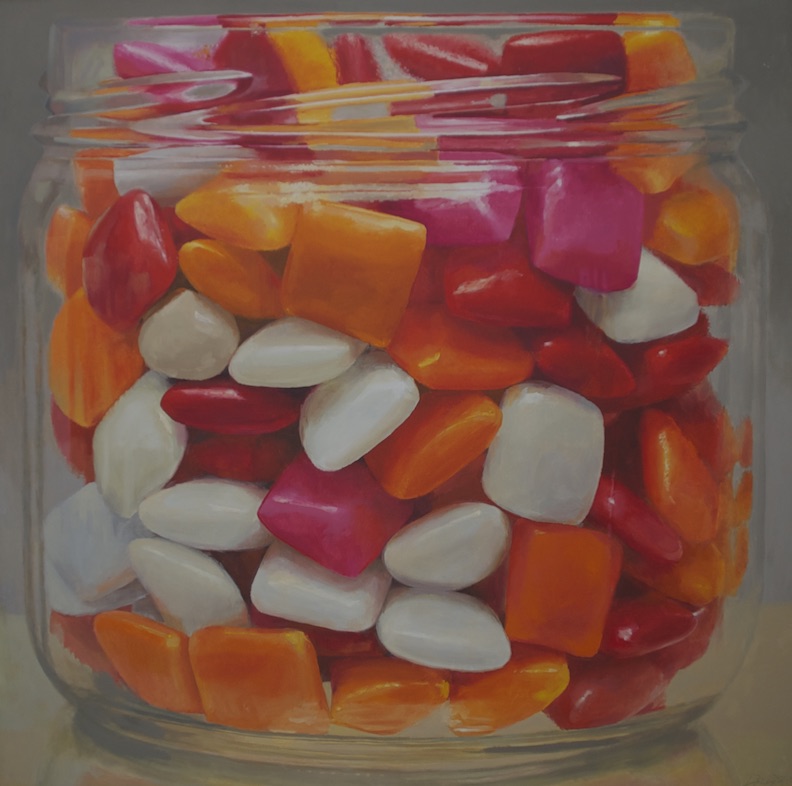
Candy Jar #9, oil on canvas, 52″ x 52″
Candy Jar #9 will be on view at The Red Biennial, from Nov. 8 through Dec. 21, in Cambridge, Massachusetts, at the Kathryn Schultz Gallery, 25 Lowell St. The exhibition was curated by Joseph D. Ketner II is the Henry and Lois Foster Chair in Contemporary Art Theory and Practice at Emerson College, Boston. This is one of the series of jars I’ve done and may return to, in a slightly smaller format, next year.




 stamina and grit I applied to its execution, lingering for quite a while on the clear poly carton for the berries and the coffee maker behind it. I managed to catch some subtle effects of multiple light sources in a way that I haven’t attempted in any other painting. In reality, there were actually ten different sources of light present in this little domestic tableau: three windows and seven artificial lights situated in different places throughout the kitchen. You can see the ceiling lights reflected as little orbs in the stainless steel bands and lid of the French press. And yet with all that light, coming from nearly every direction, some areas of color nearly melt into others because they are tucked away and shielded from most of the direct light.
stamina and grit I applied to its execution, lingering for quite a while on the clear poly carton for the berries and the coffee maker behind it. I managed to catch some subtle effects of multiple light sources in a way that I haven’t attempted in any other painting. In reality, there were actually ten different sources of light present in this little domestic tableau: three windows and seven artificial lights situated in different places throughout the kitchen. You can see the ceiling lights reflected as little orbs in the stainless steel bands and lid of the French press. And yet with all that light, coming from nearly every direction, some areas of color nearly melt into others because they are tucked away and shielded from most of the direct light.


